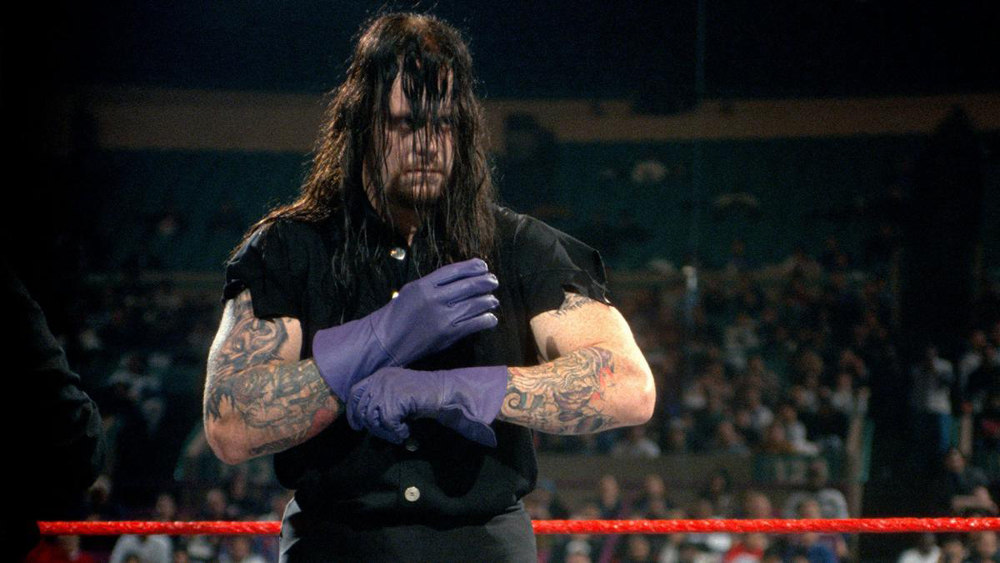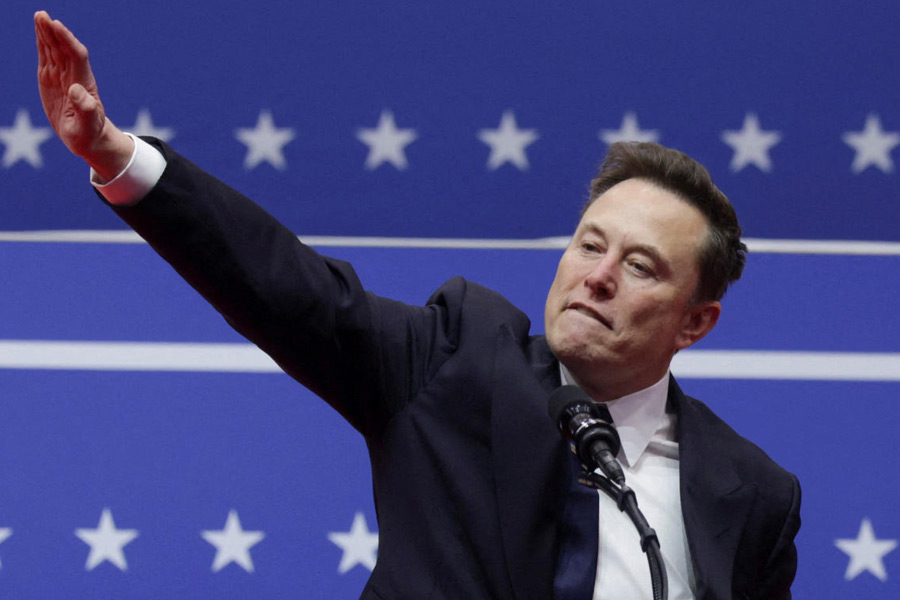As The Undertaker turns 55, a lifelong fan of the Phenom describes what made the wrestler’s gimmick the crowning achievement of in-ring storytelling, until it was allowed to capitulate.
I was scared out of my wits. While surfing through the television, my eight-year-old self had accidentally stumbled upon a sight I can never forget, for here was a seven-foot monster in a trench coat, pacing through darkness at the beck of a gong, flashing his tongue like a zombie and rolling his eyeballs out of sight — a creature who defied belief in his appearance and agility, darting around the ring like a menace unleashed from a dystopian fantasy. Here was, before my incredulous eyes, the inimitable sight of The Undertaker.
Hoodwinked but hooked
It was the summer of 2008, and The Undertaker had succumbed in a tables, ladders, and chairs match to the cunning Edge, leading to his “banishment” from WWE. A disconsolate me was raging at Edge’s underhanded means of victory, distraught that after two years of marvelling at the most enigmatic athlete I had ever witnessed, I would never get to see The Undertaker again. I vowed to quit watching WWE and coaxed my parents into buying me a PlayStation, where the world of video games — in which The Undertaker was still present — would be my refuge.
A couple of months later, The Undertaker was back (leading my naive vow to collapse), exacting his revenge on Edge and sending him crashing through the ring, before raising his arms to condemn the mangled body of his opponent in flames. I was awestruck, not only at the supernatural powers of my favourite wrestler, but at his ravaging ruthlessness, which far from tainting him with villainy, made him a peculiar symbol of karmic justice, a confounding messiah adored by legions of enthralled observers.
It was another couple of years before I comprehended the full scale of my delusion. WWE was not an arbitrary arena of competition like the rest of sports, but a meticulously designed spectacle whose results were preordained and competitors crafted, for the purpose of gripping storytelling. In other words, it was a live soap opera unfolding before the audience, without any cuts or retakes. The Undertaker was not some extraterrestrial taken to pounding grown men as a side hustle to his funeral duties, but a Texan by the name of Mark Calaway, who, barring his extraordinary talents at wrestling and acting, was a normal human being, a husband, a father, a devout Christian allergic to cucumbers. And yet, instead of being disenchanted with the simulated nature of professional wrestling, I was committed to it, my allegiance as an admirer secured by my inability to extricate myself from the story of The Undertaker.
A tombstone for greatness
Since its debut in 1990, the foundational myth behind The Undertaker’s persona had been that of darkness. He was an agent of the Dark Lord (or Satan, or whatever suits your bill of unadulterated evil), a reaper of souls whose external stoicism was a grim reflection of his internal coldness — he was a man (if such a thing can be called a man) without a heart, or compassion or remorse. Complete with an urn and an eccentric manager called Paul Bearer, The Undertaker wreaked havoc through the ’90s, emerging as a mainstay in an industry where gimmicks have been forced to extinction in weeks.
The baffling personality of The Undertaker was complemented by his in-ring arsenal. He could dance on the top rope, land explosive leg drops on ringside, wade through the air (unseen for a performer of his size) with equanimity, sit up out of the blue just when it seemed he was beaten, chokeslam his foes “through hell”, powerbomb them courtesy his “last ride”, before leaving them to “rest in peace” with his trademark finishing move, the tombstone piledriver.
Notwithstanding the unprecedented reception The Undertaker received from the fans — who celebrated him as the brooding anti-hero, a foil to the traditional baby faces (fan favourites) of wrestling — WWE was always one step ahead of the game. By means of constant adjustments to his character, The Undertaker was prevented from ever going stale.
Every few months there would be a new nuance, either in his attire or his armour, a fresh act previously deemed inconceivable. During this period of domination, The Undertaker would throw a man off the top of a near
20-foot cage, conduct ceremonial sacrifices of his “victims” by chaining them to the cross (yes, WWE got away with all this before the PG era of television), and even bury alive (for the sake of the camera only) those that dared to stand in his way. With The Undertaker at the forefront, there was no stopping WWE in its march to pro-wrestling monopoly, with no stone of sensational storytelling left unturned.
At the turn of the century, WWE decided to temporarily cast aside Calaway’s Dead Man gimmick, giving him a new role to explore — that of the American Badass. Instead of the slow, measured stroll to the ring, with a dirge greeting his arrival, The Undertaker— his head wrapped in a bandanna scarf— stormed in riding a Harley-Davidson motorbike, embodying a no-nonsense style as Limp Bizkit’s Rollin’ blared in the background. This drastic refashioning would last for a handful of years to kick-start the ’2000s, with the comeback of the vaunted Dead Man reinstating the original identity of The Undertaker in 2004.
All good things must die
Beyond the chilling entrance, the still more chilling promos and vignettes, and the numerous other captivating theatrics, the most instrumental factor in my Undertaker fandom was the “Streak”. Between 1991 and 2013, The Undertaker had recorded an astounding 21 victories at WrestleMania — the most anticipated annual extravaganza in sports entertainment. Smitten by his aura of invincibility at WrestleMania (despite knowing fully well the modus operandi of WWE), I had formed a deep, personal attachment with the “Streak”. Year after year, no matter the vicissitudes of adolescence, there was the certainty of The Undertaker’s victories at WrestleMania to reassure me that for everything else that was mutable to the laws of life, one man on one stage on one night, was not. Until 2014 and the 30th instalment of WrestleMania.
When the referee’s hand hit the mat for the three-count certifying Brock Lesnar’s defeat of The Undertaker at WrestleMania XXX, I refused to accept what had happened. It took me half a dozen replays to register that The Undertaker had lost, such was my conviction (and I was not the only one) in its impossibility.
In hindsight, ending The Undertaker’s streak was a brutally commercial decision, meant to culminate the journey WWE had sent its star employee on, to reap the rewards for maximising shock in a sport where every outcome is scripted. It speaks volumes of the magic of WWE’s storytelling that millions like myself had bought into the hype of the “Streak” and the illusion that it could never be broken. For my part, I was devastated, for gone with the Streak were the remnants of my childhood self, which had survived by being sincerely wedded to the disposition that seeing really is believing.
Three years later in 2017, The Undertaker would lose once more at WrestleMania, this time to Roman Reigns. After the match, which had exposed the toils of age and injury on his tortured body, The Undertaker would leave his gloves, hat, and coat in the centre of the ring, hobbling into the sunset in what felt the right way to go, an understated yet heart-warming swansong for a champion who, for the first time in the boots of his character, looked ordinary, looked human.
Accursed resurrection
One of the problems with building a legacy is the irrepressible urge to keep invoking it. This is the classic mistake WWE has repeated with The Undertaker. Rather than allowing his character to dissolve into the darkness from whence it came, they have brought it back — over the last three years — in bits and spells to sell out arenas and revive interest in a period of derelict decadence.
Unfortunately, The Undertaker is not what he used to be. In the age of instant and perpetual access driven by social media, the character I fell in love with has been appropriated whenever and however it has been prudent for its creators. The Undertaker is now on Instagram, his latest adversary A.J. Styles recently referenced his wife (Michelle McCool) and even addressed The Undertaker by his real name. Clearly, there is no mystery any more, no intangible sphere of separation that used to cocoon the existence of The Undertaker, investing him with a story that made him untouchable, and yet, never out-of-touch.
On April 5, The Undertaker will fight A.J. Styles at WrestleMania in what would have been a dream contest a decade ago. But now, reduced to a shadow of his former self, The Undertaker is just another legend who failed to acknowledge when his time had come.
While I shall still tune in every time The Undertaker is resurrected and put back into the squared circle, I can no longer watch with the wide-eyed wonder of a child taking in the haunting magic of the Dead Man, but with the resignation of an adult for whom the present, obsolete Undertaker is simply a dead character incapable of telling old tales.










